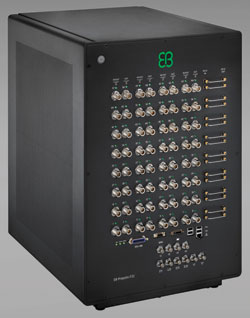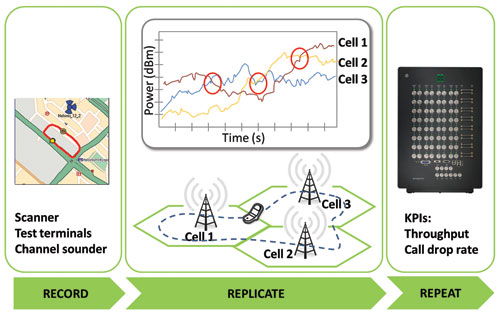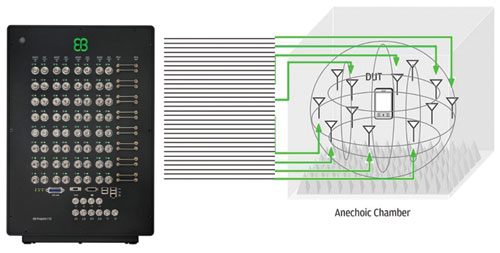
Wireless systems are evolving toward high-quality services with higher data rates, requiring new wireless technology innovations that are able to meet the increased demand for high data rate applications. Physical layer performance improvements are being implemented, e.g. LTE technology is based on wider bandwidths, adaptive multi-antenna technologies – multiple-input, multiple-output (MIMO) – and in further 3GPP LTE-Advanced technology, enhanced transmission schemes like carrier aggregation and coordinated multipoint (CoMP).
Physical layer performance depends strongly on radio channel characteristics, especially in MIMO technologies, since MIMO offers significant performance gain in data throughput, quality of service (QoS) and cell coverage without additional bandwidth or signal transmit power. Hence, MIMO technologies, such as spatial multiplexing (SM), beamforming (BF) and spatial diversity are setting challenging requirements for radio channel modeling and emulation capability in testing wireless communication networks and devices. At the same time as the technology evolution, time to market expectations are rising despite the more complex technology, requiring more effective design and verification methods and calling for more capacity, accuracy and effectiveness compared to past development methods.
Therefore, EB (Elektrobit) has introduced a new EB Propsim® F32 radio channel emulator product to meet the demanding design and verification challenges of today’s and future wireless technologies. It is designed for testing complex MIMO scenarios as well as enhanced transmission schemes. In addition, all these different test scenarios can be carried out either traditionally as conductive test via coaxial cable connections or Over-the-Air (OTA) together with the EB MIMO OTA application.
MIMO Testing
EB Propsim F32 emulates the typical radio channel characteristics like path loss, multipath fading, delay spread, Doppler spread, polarization and spatial parameters such as Angle of Arrival (AoA) and Angular Spreads (AS), which are critical for MIMO system performance. It is designed for LTE testing supporting carrier bandwidth up to 40 MHz and frequency bands up to 2700 MHz, and features a compact and highly integrated design.
The new channel emulator is also scalable and allows the tailoring of the product configuration to current needs and the upgrading of features as technologies evolve. EB Propsim F32 can emulate up to 128 independent fading channels simultaneously representing bi-directional 838 MIMO emulation capability needed, e.g. in multi-user MIMO testing.
Now, typical TD-LTE beamforming or advanced MIMO OTA test systems can be equipped with a single radio channel emulator, making test setup and configuration cost effective, quick and easy, without the need for external hardware components and complicated synchronization of multiple instruments in the test system. High emulation capacity and high channel fidelity combined with excellent RF performance simplifies the test system installation and configuration for multi-antenna and multi-radio testing.
Intelligence Built-in
EB Propsim F32 has intelligent internal signal summing and splitting designed for testing of different link topologies with user-defined antenna connections to the instrument. Flexibility in physical antenna connections, integrated local oscillators and signal duplexers together provide convenient and reliable test system installation with good support for remote use and 24/7 test automation, even for multi-RAT testing.
It is equipped with the standard Windows XP embedded operating system that is familiar to any user and therefore the emulator is easy to configure for remote desktop use when the laboratory facility and office desk are in different locations. The radio channel emulator ensures low operating costs by fast test system configuration and convenience of channel modeling capabilities.

Figure 1 Virtual drive testing with EB Propsim F32 enables MIMO handover scenarios incorporating three or more simultaneous base stations in a single lab instrumentation.
Virtual Drive Testing
The EB Propsim F32 makes it easy to improve test effectiveness by creating realistic Virtual Drive Testing (VDT) (see Figure 1) or network level test scenarios including multiple base stations and user terminals in repeatable lab conditions. Traditional field-testing of wireless systems is labor intensive, time-consuming and expensive. Also, getting consistent results is a challenge. EB’s VDT application together with the high capacity EB Propsim F32 solves these problems by enabling VDT in laboratory conditions.
VDT utilizes the field measurement data from real live networks captured by drive test tools or channel sounders in order to create repeatable real-world like conditions to laboratory testing. All the elements of the real environment: fast fading, Doppler, signal level variations, interference and antenna parameter effects can be replicated, making it possible to isolate performance issues early in the development and design verification phase.
Being compatible with various drive test tools, EB VDT with the new EB Propsim F32 is a powerful solution for operators, network, device and chipset manufacturers by verifying the performance and interoperability under different realistic field conditions. The new radio channel emulator allows simultaneous connection, e.g. three base stations and five terminals or five groups of terminals for bi-directional LTE 2×2 MIMO testing. This setup enables true performance testing, including different hand-over scenarios, scheduling, power control, etc., under dynamic and realistic propagation conditions.
MIMO OTA Testing
EB MIMO OTA application expands the usage of the EB Propsim F32 from traditional conductive testing to MIMO OTA testing. MIMO OTA testing is a state-of-the-art test method for mobile device, chipset and antenna designers and manufacturers working on MIMO technologies. MIMO OTA testing with the new radio channel emulator enables the evaluation of the end user experience of the final product, e.g., in terms of data throughput, against realistic radio channel conditions where performance varies greatly according to environment.

Figure 2 The EB Propsim® F32's compact design allows a higher number of probes in the MIMO OTA chamber.
The unit’s compact design also allows a higher number of probes in the MIMO OTA chamber (see Figure 2), thus radiated multipath signals generate more accurate radio channel environment around the DUT. EB Propsim F32 in MIMO OTA testing enables the real-world performance evaluation by providing the answer to the question, “How good is my terminal?”
Accelerated Development Cycles
Realistic field scenarios in laboratory testing at the early development stages provide immediate feedback and facilitate the improvement of product maturity before field trials, thus accelerating the product development cycles and yielding better product quality. EB Propsim F32 provides high capacity and convenience for testing demanding broadband multi-antenna wireless devices as well as complex and realistic network level test scenarios in laboratory conditions. Testing with the new radio channel emulator provides good network performance, high quality user experience of devices and hastens the time to market of new wireless devices and systems.
EB (Elektrobit),
Oulu, Finland
+358 40 344 3759,
email: rcpsales@elektrobit.com,
www.elektrobit.com/ebpropsim.
